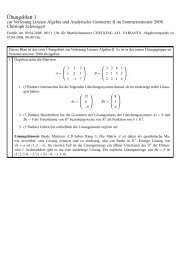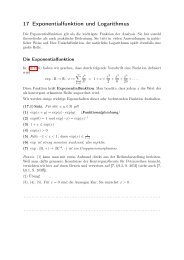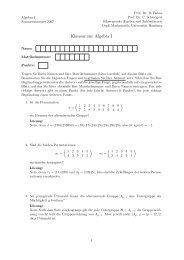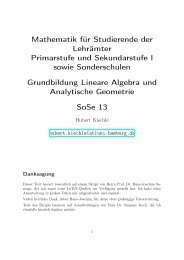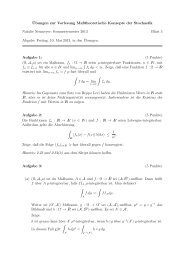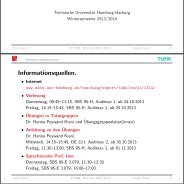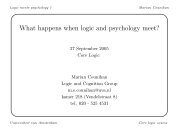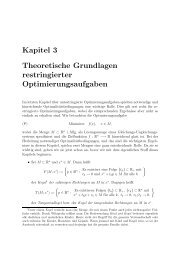pdf file
pdf file
pdf file
Create successful ePaper yourself
Turn your PDF publications into a flip-book with our unique Google optimized e-Paper software.
We apply this to the two elements in B<br />
We compute:<br />
(ρ ∗ μ)(x ⊗ y) = ∑ x⊗y<br />
H ⊗ H → H<br />
ν : x ⊗ y ↦→ S(y) ∙ S(x)<br />
ρ : x ⊗ y ↦→ S(x ∙ y)<br />
ρ((x ⊗ y) (1) ) ∙ μ((x ⊗ y) (2) ) [defn. of the convolution ∗]<br />
= ∑ ρ(x (1) ⊗ y (1) )μ(x (2) ⊗ y (2) ) [defn. of the coproduct of H ⊗ H]<br />
= ∑ S(x (1) y (1) )x (2) y (2) [defn. of ρ and μ]<br />
= ∑ (xy)<br />
S((xy) (1) )(xy) (2) [Δ is multiplicative]<br />
= ηɛ(xy) [defn. of the antipode]<br />
= 1 B (x ⊗ y)<br />
It is instructive to do such a calculation graphically:<br />
S<br />
S<br />
= =<br />
The first equality is the multiplicativity of the coproduct in a bialgebra, the second is the<br />
definition of the antipode.<br />
On the other hand, we compute μ ∗ ν:<br />
S<br />
S<br />
= = = =<br />
S<br />
S<br />
S<br />
ηɛ(x) ∙ ɛ(y) = ηɛ(x ∙ y)<br />
where in the last step we used that the counit ɛ is a map of algebras.<br />
Finally, the equality defining the antipode<br />
can be applied to 1 H and then yields<br />
id ∗ S = ηɛ ,<br />
1 H ∙ S(1 H ) = id ∗ S(1 H ) = ηɛ(1 H ) = 1 H ,<br />
where the first equality is unitality of the coproduct Δ and the last identity is the unitality of<br />
the counit ɛ. This identity in H implies S(1 H ) = 1 H . The assertions about the coproduct are<br />
proven in an analogous way: use the identity<br />
Δ ◦ S = Δ −1 = (S ⊗ S) ◦ Δ copp in Hom(H, H ⊗ H) .<br />
34






